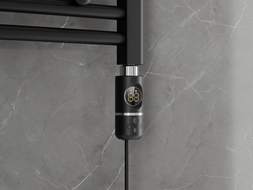
A bathroom is a place associated with a considerable amount of moisture and a temperature higher than in other parts of the apartment. Due to this, when arranging a bathroom, we somewhat automatically choose to finish the walls and floor with tiles. It is the most commonly chosen solution because ceramic tiles not only perfectly protect the walls and floor from water but are also easy to keep clean. However, not everyone likes this idea. If you belong to the group of people looking for an alternative idea for finishing the bathroom, if you are interested in a bathroom without tiles because you believe it is an interesting way to finish walls - check out our ideas.
What to use for wall finishing in the bathroom instead of tiles?
The installation of tiles is still considered the best and, for some, the only solution regarding finishing walls and floors in the bathroom. This applies especially to surfaces in wet zones, i.e., under the shower and around the bathtub. It's hard to disagree that the effect of moisture negatively impacts the structure of the wall or floor, which, without proper protection, may start to develop mold. That is why most people choose glazing for floor finishing and tiles for the walls.
However, there are many other materials that you can use in your bathroom. An intriguing proposal could be natural wood available in various colors; especially exotic species are a great idea and have a unique charm. Another idea may be the use of natural stone or even architectural concrete. Some choose to paint the bathroom – acrylic paints can be used, and vinyl wallpapers, which come in a huge variety of patterns and colors, also present interesting options. In other words, a bathroom without tiles is possible!
What to use under the shower instead of tiles?
The most problems may arise from properly securing the walls and floor in the wet zone. Frequent water activity and temperature changes mean that all surfaces are exposed to damage under the influence of moisture. Therefore, ceramic tiles resistant to water are most often laid here, especially if we choose a shower without a cubicle and tray. In such a situation, you can reach for concrete slabs specifically designed for use on the shower floor. The slightly rough surface also provides an anti-slip function.
Another material could be natural stone, which can serve as a unique finishing element. It fits perfectly both with modern tempered glass that replaces the classic shower cubicle and with the bathtub enclosure. Natural stone can be found in various sizes, making it easy to match it to your needs. A bathroom without tiles featuring natural stone will be stunning!
.jpg)
Bathroom with wood instead of tiles
Wood paneling has been an inseparable element of many homes for years, and it could also be found in kitchens and bathrooms. Nowadays, wood is not one of the most commonly chosen finishing materials in this room. However, it's worth remembering if you want to arrange a bathroom without tiles in a somewhat nostalgic style. Wooden elements can appear in the part of the bathroom that is not directly exposed to detergents and water. It's important to remember that wood is demanding; its surface must be regularly impregnated, or it will quickly lose its luster. Both furniture and bathroom accessories made of wood require proper treatment to maintain their unique appearance.
What else can you use for interior decoration without tiles?
A modern bathroom without tiles offers a really large number of potential solutions. In addition to the mentioned ideas, such as architectural concrete, natural stone, or wood, you can use options like vinyl or laminated panels, epoxy floors, and on the walls, you can use waterproof wallpapers glued with waterproof adhesive. In an economical version, you can simply choose to paint the walls with suitable paint. This solution is significantly cheaper than all the others.
The advantages of a bathroom without tiles are primarily an original appearance and the possibility of selecting finishing materials in such a way that it truly becomes a cost-effective bathroom. A small bathroom really doesn’t have to cost much; instead of tiles, you can choose other materials equally resistant to moisture and steam. Explore the offers available online; maybe in your interior, paint on the walls and concrete on the floor will work better than tiles?



















